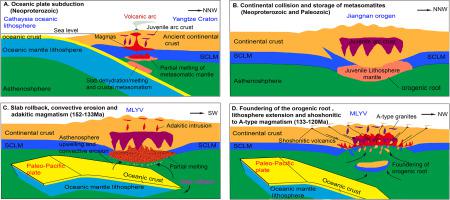当前位置:
X-MOL 学术
›
Earth Sci. Rev.
›
论文详情
Our official English website, www.x-mol.net, welcomes your
feedback! (Note: you will need to create a separate account there.)
Origin of arc-like magmatism at fossil convergent plate boundaries: Geochemical insights from Mesozoic igneous rocks in the Middle to Lower Yangtze Valley, South China
Earth-Science Reviews ( IF 10.8 ) Pub Date : 2020-12-01 , DOI: 10.1016/j.earscirev.2020.103416
Long Chen , Yong-Fei Zheng , Zi-Fu Zhao
Earth-Science Reviews ( IF 10.8 ) Pub Date : 2020-12-01 , DOI: 10.1016/j.earscirev.2020.103416
Long Chen , Yong-Fei Zheng , Zi-Fu Zhao

|
Abstract A lithological association comprising high-K calc-alkaline (HKCA) intrusions and shoshonitic volcanics, sometimes with A-type granites, is common along fossil convergent plate boundaries. Although igneous rocks in this association show arc-like geochemical signatures, their genetic link to subduction of oceanic slabs has been generally overlooked because their present occurrences are far away from modern subduction zones. This issue is addressed by an integrated study of Mesozoic igneous rocks from the Middle to Lower Yangtze Valley (MLYV) in South China. These igneous rocks have their lithologies starting from gabbroic to granitic HKCA intrusions with rare lamprophyres, followed by mafic to felsic shoshonitic volcanics/subvolcanics with slightly younger A-type granites. All of the mafic igneous rocks exhibit typical arc-like trace element distribution patterns with significant enrichment in LILE and LREE but depletion in HFSE. The HKCA intrusions are generally more enriched in Sr-Nd-Hf isotope compositions than the shoshonitic volcanics/subvolcanics and A-type granites with some overlap. Whereas the less enriched Sr-Nd isotope compositions for these Mesozoic arc-like igneous rocks in the MLYV are comparable with the continental arc igneous rocks of Neoproterozoic age in the Jiangnan orogen between the Cathaysia terrane and the Yangtze craton, the more enriched ones suggest involvement of the ancient continental crust in their magma sources. As such, the mantle sources for the Mesozoic mafic igneous rocks would be generated by previous metasomatism of the mantle wedge, which is most likely related to subduction of the Cathaysia oceanic slab beneath the Yangtze craton in the Early Neoproterozoic. The shoshonitic mafic rocks become less and less enriched in potassium relative to sodium with time, which is associated with a decrease in their Rb/Sr ratios and an increase in their eNd(t) values. Such compositional changes indicate a progressive transition of their mantle sources from a more enriched phlogopite-bearing one to a less enriched amphibole-bearing one. In association with the gradually less enriched Nd isotope composition, furthermore, there are systematical decreases in both Sr/Y and (La/Yb)N ratios and increases in both Y and Yb concentrations from the felsic HKCA rocks through the felsic shoshonitic rocks to the A-type granites. This indicates that the crustal components in the source rocks for the Mesozoic felsic igneous rocks in the MLYV have changed from the more enriched ancient deep crust to the less enriched juvenile shallow crust. While these two aspects of transition in source lithology and geochemistry are recorded by the different compositions of igneous rocks, partial melting of the source rocks is dictated by thinning and extension of the Neoproterozoic orogenic lithosphere for destruction in the Mesozoic. The systematical younging of the mafic magmatism from the southwest to the northeast indicates that the orogenic destruction was triggered by asthenospheric upwelling in response to northeastward rollback of the subducting Paleo-Pacific (Izanagi) slab. As such, it is superimposition of the lithospheric thinning and extension on the fossil convergent plate margin that resulted in the generation of the unique rock association with the arc affinity in the continental interior.
中文翻译:

化石汇聚板块边界弧状岩浆活动的成因:华南中下游中生代火成岩地球化学认识
摘要 包括高钾钙碱性 (HKCA) 侵入体和钾长石火山岩的岩性组合,有时还有 A 型花岗岩,沿化石会聚板块边界很常见。尽管这种关联中的火成岩显示出类似弧形的地球化学特征,但它们与大洋板块俯冲的遗传联系通常被忽视,因为它们目前的产地远离现代俯冲带。对华南中下游长江流域 (MLYV) 中生代火成岩的综合研究解决了这个问题。这些火成岩的岩性从辉长岩到花岗岩 HKCA 侵入体开始,带有稀有的斑岩,其次是镁铁质到长英质火山岩/亚火山岩,带有稍年轻的 A 型花岗岩。所有基性火成岩都表现出典型的弧状微量元素分布模式,LILE和LREE显着富集,HFSE贫化。HKCA 侵入体的 Sr-Nd-Hf 同位素组成通常比橄榄岩火山岩/次火山岩和 A 型花岗岩更丰富,有一些重叠。而 MLYV 中这些中生代弧状火成岩的 Sr-Nd 同位素组成含量较低,与华夏地体和扬子克拉通之间江南造山带中新元古代的大陆弧火成岩相当,而较高的同位素组成表明其参与古代大陆地壳的岩浆来源。因此,中生代基性火成岩的地幔源可能是由先前地幔楔的交代作用产生的,这很可能与早新元古代扬子克拉通下华夏洋板块的俯冲有关。随着时间的推移,钾镁铁质岩石相对于钠的富集越来越少,这与它们的 Rb/Sr 比值降低和 eNd(t) 值增加有关。这种成分的变化表明,它们的地幔来源从富含金云母的地幔源逐渐过渡到富含角闪石的地幔源。此外,随着 Nd 同位素组成逐渐减少,Sr/Y 和 (La/Yb)N 比率系统性降低,Y 和 Yb 浓度从长英质 HKCA 岩石通过长英质英长岩到A型花岗岩。这表明 MLYV 中生代长英质火成岩烃源岩中地壳成分已由较富集的古老深部地壳转变为较不富集的幼年浅部地壳。虽然源岩性和地球化学转变的这两个方面是由火成岩的不同成分记录的,但源岩的部分熔化是由新元古代造山岩石圈变薄和伸展以在中生代被破坏所决定的。基性岩浆活动从西南向东北的系统年轻化表明,造山带的破坏是由俯冲古太平洋(伊邪那岐)板块向东北回滚引起的软流圈上升流引发的。因此,
更新日期:2020-12-01
中文翻译:

化石汇聚板块边界弧状岩浆活动的成因:华南中下游中生代火成岩地球化学认识
摘要 包括高钾钙碱性 (HKCA) 侵入体和钾长石火山岩的岩性组合,有时还有 A 型花岗岩,沿化石会聚板块边界很常见。尽管这种关联中的火成岩显示出类似弧形的地球化学特征,但它们与大洋板块俯冲的遗传联系通常被忽视,因为它们目前的产地远离现代俯冲带。对华南中下游长江流域 (MLYV) 中生代火成岩的综合研究解决了这个问题。这些火成岩的岩性从辉长岩到花岗岩 HKCA 侵入体开始,带有稀有的斑岩,其次是镁铁质到长英质火山岩/亚火山岩,带有稍年轻的 A 型花岗岩。所有基性火成岩都表现出典型的弧状微量元素分布模式,LILE和LREE显着富集,HFSE贫化。HKCA 侵入体的 Sr-Nd-Hf 同位素组成通常比橄榄岩火山岩/次火山岩和 A 型花岗岩更丰富,有一些重叠。而 MLYV 中这些中生代弧状火成岩的 Sr-Nd 同位素组成含量较低,与华夏地体和扬子克拉通之间江南造山带中新元古代的大陆弧火成岩相当,而较高的同位素组成表明其参与古代大陆地壳的岩浆来源。因此,中生代基性火成岩的地幔源可能是由先前地幔楔的交代作用产生的,这很可能与早新元古代扬子克拉通下华夏洋板块的俯冲有关。随着时间的推移,钾镁铁质岩石相对于钠的富集越来越少,这与它们的 Rb/Sr 比值降低和 eNd(t) 值增加有关。这种成分的变化表明,它们的地幔来源从富含金云母的地幔源逐渐过渡到富含角闪石的地幔源。此外,随着 Nd 同位素组成逐渐减少,Sr/Y 和 (La/Yb)N 比率系统性降低,Y 和 Yb 浓度从长英质 HKCA 岩石通过长英质英长岩到A型花岗岩。这表明 MLYV 中生代长英质火成岩烃源岩中地壳成分已由较富集的古老深部地壳转变为较不富集的幼年浅部地壳。虽然源岩性和地球化学转变的这两个方面是由火成岩的不同成分记录的,但源岩的部分熔化是由新元古代造山岩石圈变薄和伸展以在中生代被破坏所决定的。基性岩浆活动从西南向东北的系统年轻化表明,造山带的破坏是由俯冲古太平洋(伊邪那岐)板块向东北回滚引起的软流圈上升流引发的。因此,

































 京公网安备 11010802027423号
京公网安备 11010802027423号